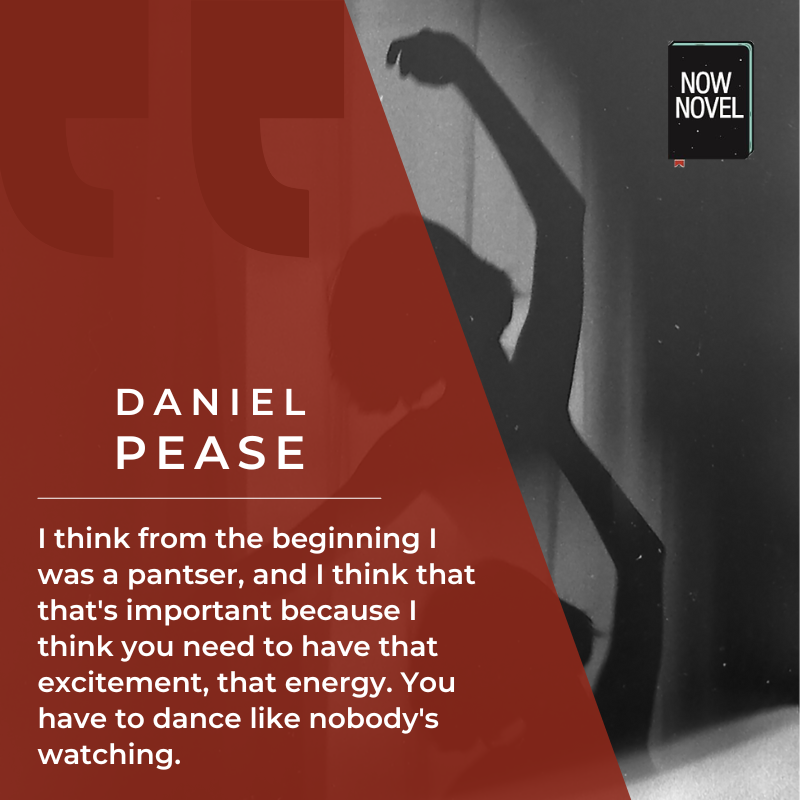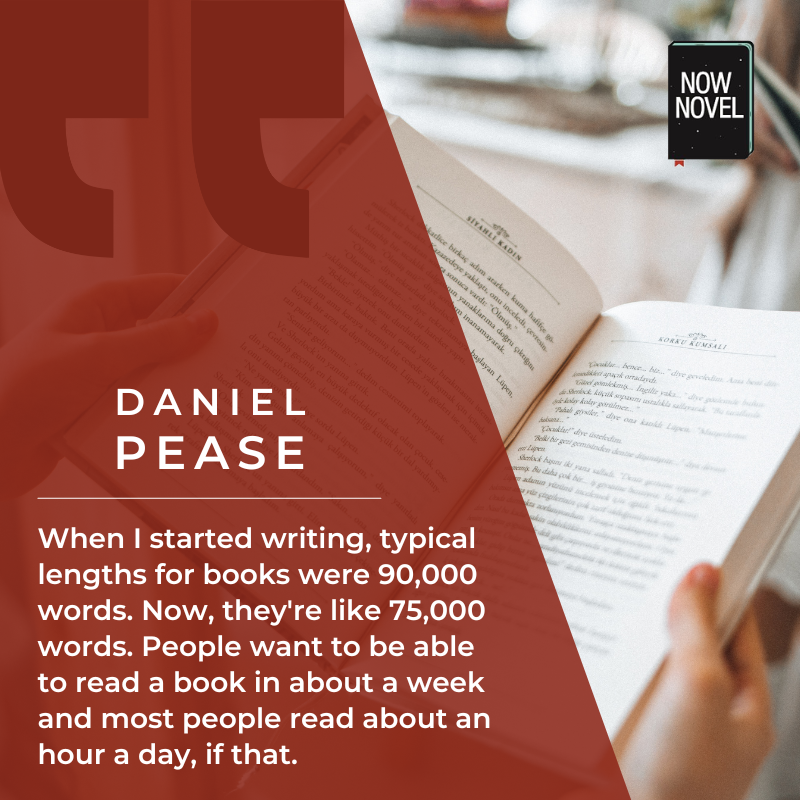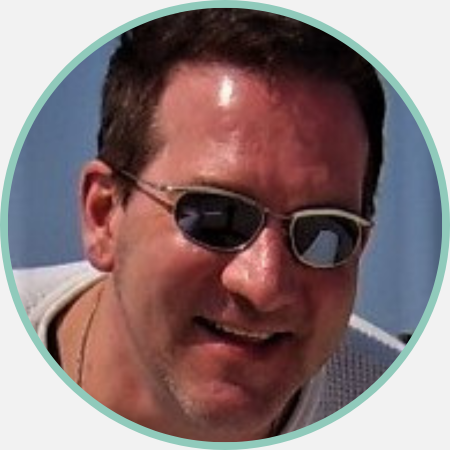Watch the video interview with Daniel Pease or read the full transcript of this chat below:
Starting to write
Brendan: Today, we are lucky enough to chat to Daniel. He has written and published a fascinating story that we’re going to hear about a little bit more over this interview. I want to try and dig into a little bit behind Daniel’s process – how he actually got around to writing, editing, and publishing his book. What inspired you to write this book?
Daniel: Well, I appreciate that, Brendan. I’m not sure if there’s anything that really inspired me per se. I’ve been reading for quite a while. From a young age, I’ve always liked detective stories and I also like the ocean – I like boats and stuff. I got pretty sick about five years ago and I wasn’t able to work so I sat down and I just sort of started looking at websites on how to write and I started writing a story with somebody and it just kind of morphed into this over the course of about four years.
Brendan: So you just came up with the idea and then four short years later you had your book. So you didn’t have a specific genre or topic that you thought would lead you into it – just the story kind of coalesced as you were writing?
Daniel: I had read most of the Hardy Boy books by the time I was probably six or seven years old. I had read most of the Sherlock Holmes stories by the time I was in junior high school. But the Travis McGee books, the John D. McDonald books, the ones that have the color, you know, the deep purple sky, the fearful yellow eye, those were probably the strongest for a long time and then Sue Grafton came along in the late 1980s. I guess I was in high school at that point and I was really impressed with her voice and you will see that between John D McDonald and Sue Grafton, there is a lot of Leland Chase.
Originally my character was supposed to be a lot more like Travis McGee but that character is a little bit dated. So I had to shift it a little bit more for the sensibilities of today.

The writing process
Brendan: Fair enough, we live in a different world or a new world so it’s worthwhile keeping abreast of that or understanding about that. I’m not sure if you’re familiar with the terms plotter and pantser, but basically, do you start with a clear outline of who your characters are, what your character arc is, and then fill in everything and then just write from there or do you are you more of a flying by the seat of your pants kind of guy?
Daniel: I think from the beginning I was a pantser, and I think that that’s important because I think you need to have that excitement, that energy. You have to dance like nobody’s watching. You have to do that in the beginning; but at some point and especially with mysteries, it becomes so complicated you have to start writing things down so I have the index cards. I have the charts. I’m doing one right now, starting another book and I encourage people to develop their characters early. You don’t need to write everything about your character but I think you need to know who his favorite teacher was in the fourth grade. I think you need to know his first car.
I think you need to know a lot about the characters so that you can create reactions down the line. And then I do kind of write about the first 20 or 30 pages, really just whatever I’m often inspired by things that are in real life. I really like dialogue. I think dialogue is extremely important, otherwise it sounds like a series of events. But writing dialogue is very challenging.
Brendan No, I think it’s very cool. I think it’s a great visceral way of understanding what you’re doing. Can you talk a little bit about your process?
I’m just intrigued to know, for example, you got the cards. Where do the cards get written individually? Do they get scratched out and edited? How do you organize that and how does that correlate with the charts? It’s always interesting to understand people’s processes.
Daniel: That’s an excellent question because I don’t think any of this actually, like if you took my stack of cards, you would not be able to write that book. If you took all of my charts, you would not be able to write that book. At some point you have to let that go, then you have to start writing from the heart and you have to let the story come from within. But I do think you need to have the organization.
I do look at [writing] around 300 pages, so you know that’s about 75,000 to 80,000 words. So I do have some limits on that and I had a couple of coaches have said that if you put limits on it, you’ll be a lot more creative because then you do have to find the perfect word. You do have to narrow down your setting. You do have to focus. One of the things that I found very helpful with my outlining is I know that there’s going to be about 50 or 60 beats and those are chapter headings. If you put a chapter heading and put the characters in it, I find it very helpful because I’m not really looking at the plot point per se, that’s just one thing, but there’s five characters in that scene or there’s five characters in that chapter and I have to give them all fair time and I have to get information out. So I start with the question and then at the very end we have the wrap up and hopefully everyone says, ‘I wonder what they meant by that’ and then [they] gotta read, you know, turn to the next page. So that’s kind of the process of how I actually work. But I do spend a lot of time sitting, looking at my computer, going and researching something. If I write about guns, I really want to know because I don’t like people coming back and saying, ‘Well, that would never happen.’ And maybe that’s a good thing.
Research
Brendan: So let’s talk about that a little bit more in detail. How do you research? What kind of research do you do? Are you the kind of guy who watches YouTube videos? Are you a Wikipedia nut or is it everything and anything?
Daniel: I am a Wikipedia nut and I do think that Wikipedia has a great sort of basic information on that. Wikipedia can also give me a lot of good visual information. When I want to look at some place that I’ve never seen, I will go to either Google Maps or Wikipedia and get pictures out of that. I love Google Maps because not only can you see it geographically, but you can look at a town. I could write a story about wherever you are and come right down and put it in relation. You know, the motels, the hotels, the restaurants, and the pawn shops and so forth. But I agree that you can do too much. I have had people comment on that. Do we really need to know that much about…? I write a lot about what people are wearing. Do we really need to know that much about his shoes? Do we need to know that much about what her dress looks like? And I say sometimes yes, sometimes no.
Brendan: What about my very bright shirt? Do we need to know enough about that today?
Daniel: I would actually use that because it’s poignant and it’s something that helps. A lot of people don’t remember who characters are because all they have is a name. But most of the time, we remember people by kind of who they are, as opposed to just what their name is, especially in books.
Day-to-day writing routine
Brendan: We’ve talked about process a little bit. We’ve talked about your cue cards, your research process. But what about writing? How do you get to sitting down and doing it? What’s your day-to-day writing routine?
Daniel: I try to do something every day. I try to spend at least an hour getting something down and sometimes it might just be a couple of beats and not even fleshed out. I always have a working draft. I make copies of the drafts over and over and keep adding stuff to them until I’ve reached the point where I can read through it without stopping. If I can read through the 50 pages without saying, ‘Oh, I got to change that,’ then I feel pretty comfortable about that particular period. I find that my best writing comes when I have to do something later, like go pick someone up or have to go to work or take the dog out. I find that my best writing comes kind of under a deadline. I had a lot of help with having deadlines in my Alpha group and I had a coach for a while who made sure that I had 20 to 40 pages for him every week. That 40 pages went back to five pages. I think it makes sense. Everyone knows when you have to do your homework on time, that urgency cracks the whip a little bit and gets you going, even if you’re doing it in the parking lot.
Brendan: So, you took four or five years to write this from initial idea to the end of the first draft or to what sort of stage?
Daniel: Believe it or not, the first couple of years, the first three years of this, I was doing other books. I was doing other stories. I have a story that’s inside of me right now that I’m playing with and it’s very close to me and I haven’t let a lot of people see it. It’s the one that’ll come at some point. But that was the one that I was actually working with early on. Then at one point, they started asking for pages and I said, ‘Okay, well I’ve got to do something but I’m not going to let them see my baby.’

So, I created this character, Leland Chase. He really was created from creating a book cover. Originally, he was a musician who got kind of dragged into solving a murder in the building that he lived in. But I couldn’t put that together. But I could sort of copy things that were in my mind already and I got him into a position where he actually lives on the coast with his estranged son. He’s a divorced dude who used to be a lawyer in a big city and now he’s come home and he’s in his second career.
It took me a little over a year with this. In the last six months, I had people helping me, encouraging me to move along and I did. I just wrote and then when it came time to do my revisions, I started making my charts. I don’t remember who it is that suggests that you go through all of the little steps, but I do have a chart with each chapter. I use a four-act play so that I can divide it in the middle neatly. The first part is our hook, our second part is the little let’s give some information and then at the midpoint, I have the aha moment where my detective says, ‘Okay, now I understand it, now let’s go after the bad guys.’
WATCH HELPFUL WEBINARS
Register for upcoming webinars, or browse through our extensive catalog. Learn about romance writing, getting started, writing dialog and tons of other stuff
LEARN MORE
Learning to write
Brendan: You’re talking a lot of theory here and I think that’s crucial in understanding it. How did you learn how to write? It’s such a vast topic. There’s creating characters, what does a scene look like, how does dialogue hang together. There’s all of these different procedures and difficult things to learn. How do you go about doing that?
Daniel: I’m not sure how to go about doing that, but I can tell you that when I was in school, I used to write minute mysteries in class. I didn’t get a lot of learning done, but I wrote two pages of a minute mystery in class and shared it with my friends. I do encourage writers to read the simple stories. One of my favorite stories to read is Encyclopedia Brown. It’s an early reader, designed for a fourth grader, but it really shows you how in like 11 pages to put a whole story together. I like [Sherlock] Holmes because the dialogue, even though it was stilted and ornate, there’s a real snappy sort of back and forth with that. If you’re going to have a sidekick, I really like what he did with that. Holmes doesn’t say much, but Watson explains everything that’s going on with their detective work.
With Sue Grafton, she uses Kinsey Mahone’s interiority a lot. We hear mostly her voice inside her head and her experiences to flesh out that character. Her plots can be complicated, but the motive behind solving them is pretty straightforward. This is a woman who has to do this because she has no one else and this is her only source of income, so she has to succeed. She gets down to this really tight little survival thing. I do encourage people to look at Pinterest. That’s how I found Now Novel. I think it popped up on one of my Pinterest feeds, but I think that you can find a kernel of goodness in almost anything you look at.

The Now Novel process
Brendan: You’ve raised Now Novel and obviously it’s a subject close to our heart. How did Now Novel help you in this process?
Daniel: I think it’s an excellent place to get something done because you need to contribute to the group. You need to have pages available and also, I think when we look at other people’s work and when we do a little bit of teaching ourselves, it helps our work. I don’t mean this in the sense of saying, ‘Oh well, I would never do that’ or ‘That’s not the way it should be done’, but it’s a way of saying, ‘Now this is an interesting way of moving somebody from point A to point B’, which is something I have a lot of trouble with because I can spend a lot of time on what I call the road trip and that is really not good in a book that you have to keep under 300 pages. But I enjoyed the way that we were able to engage. We had tutors, guys like you and Jordan, come in and say, ‘Well, this is excellent, but here’s what your editor is going to say. This is excellent, but this is what your readership is going to see.’
Brendan: If you look at the book that you’ve written at the moment, what was the most challenging part of the process that you found?
Daniel: I think it’s bringing the resolution to a timely conclusion without feeling rushed or contrived. I had a pretty long process in doing that. I was afraid that it was going to come off as basically hokey in the end. Either that or people were going to go, ‘Oh, I didn’t know that it was about that. If I had known that it was about that, I would never have picked this book up.’ But I think that I seemed to piece it together nicely.
It’s like, have you ever seen a sports jacket being made? Seeing how tailoring works? They cut all the pieces apart, they have all those little chalk lines, and things get basted together. It doesn’t look like a jacket at all, but when it gets finished, they put the buttons on it. Maybe that’s kind of a good analogy for writing, at least a mystery. You end up with a piece of cloth and your inspiration is, ‘Here’s a piece of cloth, it was on sale, do something with it.’ So now you got to work with the color, the fabric, the pattern, and then you start cutting it apart.
Brendan: So, would you say that’s also the most satisfying part or is that too neat? Is it always tying up the jacket at the end and putting the buttons on and looking at yourself in the mirror, if I may beat a bad metaphor?
Daniel: Well, since I’m making the suit for someone else, the best part is when somebody slips into the suit and says, ‘Oh my, that feels good. That looks nice. This is a good looking suit on me.’ I guess maybe that’s the best part of it because when somebody says, ‘You know, that was a pretty satisfying read. I might not agree with everything, I might have done it differently, but yeah, I want to read another one of these books.’
‘What I wish I had known’
Brendan: What do you wish you’d known earlier about self-publishing? If you had one sort of golden rule to pass on to people, what would that be?
Daniel: I wish I had known about self-publishing and that it’s easier than you might think and it’s a lot more satisfying. I think if you’re a writer, you have to write. But at the same time, if you want to be an author, you have to have a book. I know that that sounds probably kind of strange, but yes, you can be a writer without a book. But I think if you want to be an author, I think you need a book. I think you need to have a physical book somewhere. And that physical book may exist on a Kindle app, but there has to be something out there. There has to be someone more than you, your writing buddies, your mom, your brother, reading your stuff. I think that’s the best way to do it.
I wish I had known about self-publishing and that it’s easier than you might think and it’s a lot more satisfying.
Tweet This
I also think it’s a really good way to start polishing lengths. When I started writing, typical lengths for books were 90,000 words. Now, they’re like 75,000 words. People want to be able to read a book in about a week and most people read about an hour a day, if that. So you have to have that limit. And I’m not talking about books that are epic, I’m not talking about series that go on for pages. I’m talking about what I’m doing. I’ve spoken to agents and they are looking at people who self-publish and those who have five or six books on their list. They’re observing how those books are progressing because agents need someone who can produce, someone who learns, and someone who knows a little bit about the business already. Gone are the days when somebody gets a manuscript anonymously in the mail and says, ‘Oh my gosh, I’ve got to have that.’
What’s next?
Brendan: So, last question for you, what’s next? What’s coming up?
Daniel: Well, the next book is ‘Reckless’. It is about a young man who, about 10 years ago, took the fall for his father in a deadly car accident. Leland is charged by his retained client to go pick him up as he’s being released from prison. Offhandedly, this young man makes a comment and Leyland finds himself invested. The book is on the skids, I just need to hit it with a bottle of champagne and knock it into the water. But I’m having a little bit of trouble grinding that resolution into a nice, neat, satisfying ending. Right now, I have it all together but it keeps coming out a little bit contrived. I’m dealing also with two issues for my main character. He’s going to make some pretty strong decisions about the people around him and he’s going to realize that even though he’s 51 years old, he is still kind of naive.
Brendan: Well, it sounds fascinating. Please let us know when it comes out. We’ll add the link below and share it with our readers. Thanks very much for your time today and good luck with the next one.
Daniel: Thank you for having me.
About the author

Daniel Pease entered his first writing contest at 13 and won a $25 prize along with the four-page minute mystery. He then contributed regularly to Reader’s Digest for years before having a ‘Life in these United States’ anecdote of 175 words published when he entered high school. He has always written in one form or another for work, but finally got back to serious writing a decade ago. Leland Chase and Tampico Bay were only a couple of about 10 contenders for his main character and setting. The setting for Tampico Bay is not too far from his home in the Pacific Northwest where he now resides with his husband and their irrepressible Staffordshire terrier, San Diego.


